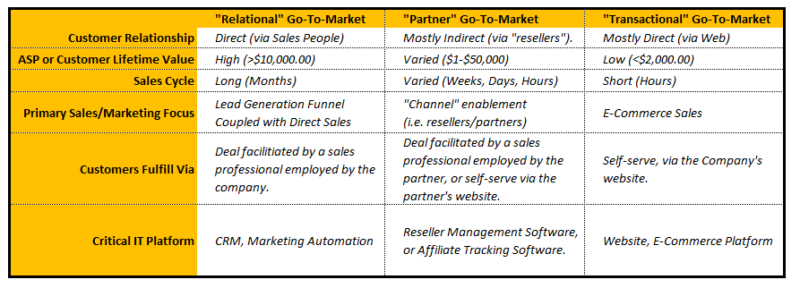Taming The Beast Of The Messy Enterprise SEM Campaign
Enterprise SEM can be a sprawling operation, but columnist Ted Ives suggests an organizational framework to keep it in hand.
Enterprise SEM campaigns are exciting to design and execute; budgets are large, and there are numerous customers to satisfy by connecting them with the information they need via a myriad of keywords and ads.
However, enterprise SEM campaigns come with three major challenges:
- They tend to grow over time and become very messy and difficult to manage
- They must maintain consistent messaging and brand voice across campaigns being run by different arms of the organization
- They need to “institutionalize” memory about the campaigns so they can provide value long after the person who created them has moved on
This article outlines the three types of businesses that you’ll typically encounter in a large enterprise, then discusses how to mentally organize and talk about SEM campaigns in a consistent way so that even people in different parts of the organization can understand each other — which is particularly important come budget time!
Note: For the purposes of this article, when I say “campaign,” I mean a targeted activity in the traditional marketing sense, not an “AdWords campaign,” etc. For example, a grouping of AdWords campaigns may be a component of a Back-to-School “campaign.”
With that out of the way, let’s examine what types of businesses you’ll find inside a typical enterprise.
The Three Types Of Businesses
A convenient way to think about a business is it’s “Go-to-Market” strategy — in other words, how does it reach its prospects and sell to them?
If you have a small or medium-sized business, there is a good chance it resembles one of the three below. If you are at a large conglomerate, you may deal with multiple businesses with different “Go-to-Markets,” and categorizing your businesses into these buckets can be very helpful when structuring your SEM campaigns.
Because each type of business has different goals and challenges, their SEM strategies (and account structures) may differ widely:
Note: When I say Partner here, I’m referring to Resellers or Distributors.
Of the three types of businesses, the “Relational” and “Transactional” businesses are actually much more straightforward from an SEM standpoint.
Campaigns for Relational businesses that are focused on lead generation (often based on whitepapers, case studies, e-books and the like) are employed frequently and can be very effective.
Similarly, campaigns designed to drive e-commerce sales for Transactional businesses are straightforward in their own right.
The middle type — the “Partner” type of business — is much more complex. The business wants to stimulate demand, but fulfillment is performed through partners such as resellers. Often, customers educate themselves on a company’s products or services at the company’s website, then go fulfill their order through a partner. This makes tracking, and measurement in general, a major challenge.
On top of that, many businesses pursue both “Partner” and “Transactional” Go-To-Markets simultaneously, which really complicates things. In such cases, SEM efforts on behalf of the company may stimulate new demand, or they might simply fulfill existing demand — worst case, they may actually cannibalize existing demand from the reseller.
The Four Types Of Enterprise SEM Campaigns
The following chart outlines the four types of enterprise SEM campaigns, which I will discuss in detail below.
Type 1: The Branding Campaign
Paid search is great to work with because it’s intent-based. This, of course, makes it problematic for non-intent-based campaigns.
A branding campaign is a classic non-intent one: you have a message, and you’re trying to get that message in front of an audience that isn’t specifically looking for you. The goal is to raise awareness — to get these potential customers to remember you when it comes time to make a purchase.
Thus, when I refer to a “branding campaign” in paid search, I don’t mean showing a brand ad in response to a brand keyword, as customers searching on your brand name are already aware of you; instead, I mean showing a brand ad on a non-brand keyword in order to reach audiences who may never have heard of you.
Since Paid Search is typically a very competitive marketplace, with keywords being bid up by businesses with more of an intent-based model, CPCs are usually too high to make a paid search branding campaign very worthwhile.
That said, there can be some limited value in generating demand via a paid search campaign, particularly if coupled with a remarketing campaign (so that acquired visitors can be brought back at a later date, hopefully to learn more about the product or service, or maybe even to convert).
In most cases though, spending a lot on a branding campaign does not makes sense in the context of paid search; display advertising or even paid social advertising can be much more cost-effective approaches to pursue.
Type 2: The Customer Acquisition Campaign
Customer acquisition campaigns include the classic B2B whitepaper download-type campaign or a B2C lead generation campaign. Cost-per-lead for B2B usually ranges from $50 to $500; for B2C, it can be lower. Often, SEM is one of the lowest-cost lead generation approaches for a marketer.
It’s useful to compare performance for this type of campaign to two other marketing activities: trade shows and webinars.
Trade shows almost always have a higher cost-per-lead than SEM; webinars can sometimes beat out SEM efforts on a cost basis. In both cases, volume can be limited; there are only so many relevant trade shows you can attend or webinars you can convince your internal thought leaders to host.
Customer acquisition campaigns are typically straightforward; the goal is simply to drive leads up and costs down. Often they can be executed almost in a vacuum; searchers can be sent to dedicated landing pages, and efforts are focused on creative messaging and landing page testing.
Type 3: The Demand Fulfillment Campaign
This type of campaign is what you would recognize as the traditional e-commerce campaign. Think of it as your “lower-funnel” transactional campaign, driving sales on your own website or e-commerce store.
Demand fulfillment campaigns are most often best implemented using Google Shopping, Bing Product Ads, shopping comparison engines or even an Amazon campaign, and they involve showing products pictures and prices.
Click-through and conversion rates can be high for these campaigns because they are focused on specific, product-focused terms: brand names, model names/numbers, and SKU numbers.
This type of campaign is all about making the final step in the purchase process as easy as possible; it’s not about supporting customers in product research or any sort of early-funnel activity. Measurement is easy — you simply measure e-commerce sales off of a company store or the like.
Where demand fulfillment campaign gets interesting is if there are partners from which customers can also purchase. In such cases, it’s important to go in on a keyword-by-keyword basis and determine, “Would the company have gotten this sale anyway through a partner?”
If the answer is yes, often the smart thing to do is to spend the money elsewhere. Why cannibalize your own partners when you have other marketing activities you could be focusing on?
It’s all about opportunity cost, and you should always be trying to find best place to put each marketing dollar to generate a net return to the company. If you have ten resellers already bidding on a term and the search result is chock-full of ads from them, why bother bidding on it yourself?
Type 4: The Demand Generation Campaign
Think of this as your “upper funnel” transactional campaign. This is the most interesting of the four types of campaigns, and it focuses on generating demand for the company that would not have existed otherwise. As such, it should focus on two types of terms: generic product/service terms and very specific competitor brand terms.
Early-funnel “research” situations and “competitive” situations are two especially critical points in the buying cycle that companies should try to target.
The challenge with this type of campaign is, of course, attribution. If you bid on a generic product term and the customer comes to your site, researches the product, then fulfills through your partners, that is a great situation. In fact, if you rely on partners for fulfillment, this is actually the ideal situation! However, it’s a double-edged sword because it makes campaign measurement itself very difficult.
For companies with “Partner” Go-To Markets that rely heavily on demand generation campaigns, there are a few approaches you can take to help quantify the value of your efforts.
1. Make Growing “Find A Reseller” Or “Where To Buy” A Goal
If your website features a “Find a Reseller” or “Where to Buy” section, you should absolutely measure visitor engagement with these sections and should probably make increasing traffic to these sections one of the goals of your paid search campaign. When a customer researches a product on your site, then goes off to a partner to fulfill, that is a great situation to try to encourage.
2. Attribution Analysis Can Help You Estimate Partner Demand You’re Stimulating
This suggestion works best for companies with both “Partner” and “Transactional” Go-To-Markets — in other words, you are selling your products both on your own website and through partners.
By running a lower-funnel demand fulfillment campaign in parallel, and by using attribution modeling (such as the capability now found in Google Analytics), you should be able to measure how many sales are happening in the demand fulfillment campaign that were initially stimulated by the demand generation campaign.
Now, take it to the next step. Think of your e-commerce store as a large “captive” reseller. If you know your online store’s “market share” versus other resellers — let’s say it’s 5% of the market…. then you can take the real returns you’ve measured based on your own “fulfillment” and scale it up to estimate the partner channel’s “fulfillment.”
A 5% share would argue for multiplying the results by 20, for instance (your own website may have an unfair advantage, so some smaller multiplier, like 10, might seem fairer to the channel). The point is, you can use attribution analysis across your campaigns to help get your arms around how much demand you are likely stimulating for partners.
Rules Of The Road To Keep These Campaigns Straight
I would propose that these simple rules make it very straightforward to organize, refer to and explain these types of campaigns:
-
For transactional situations, any brand terms of the company belong in the Demand Fulfillment campaign — which, in the ideal world, is implemented as a Google Shopping campaign, driving customers to individual product or service pages for fulfillment.
-
For transactional situations, any generic product/service terms, or competitor brand terms, belong in the Demand Generation campaign — which should be driving customer to early-funnel product/service pages, to educate them on how they can best solve their problems.
-
Any high ASP (average selling price) relational situations should simply be handled as a traditional lead-gen activity.
Conclusion
Some of the benefits of breaking out and managing campaigns in this way include:
- It makes it much easier to break down SEM efforts into smaller, manageable buckets
- The language used to describe them here can be easily applied to almost any business situation
- By keeping these campaigns separate, you can measure them differently against appropriate business goals
- By separating the “demand fulfillment” terms out, you make a “cannibalization” analysis easier
- By separating the “demand generation” terms out, you now have a go-to campaign when the boss brings you a pile of money and asks you “how can I best move the dial this quarter?”
So, which types of campaigns are you running? Which ones should you be? Any thoughts below appreciated!
Opinions expressed in this article are those of the guest author and not necessarily Search Engine Land. Staff authors are listed here.
Related stories
New on Search Engine Land


